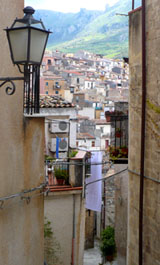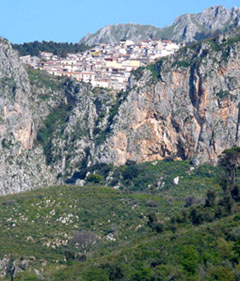An island within an island in Sicily's mountainous heart.
Sicily: the Madonie Mountains
by Sarah Shuckburgh
Art, beaches, lovely villages, fine food – the Madonie has it all, says Sarah Shuckburgh
 On a map of Europe,
Sicily looks very small. I naively expected to see the
whole island in a week. But the largest island in the
Mediterranean is packed with fascinations. You’d need months
to see everything. My husband and I rented a villa in the
foothills of the Madonie mountains, 45 miles east of
Palermo, and, apart from a day trip to the capital, we
happily spent the entire week exploring these utterly
unspoilt hills. On a map of Europe,
Sicily looks very small. I naively expected to see the
whole island in a week. But the largest island in the
Mediterranean is packed with fascinations. You’d need months
to see everything. My husband and I rented a villa in the
foothills of the Madonie mountains, 45 miles east of
Palermo, and, apart from a day trip to the capital, we
happily spent the entire week exploring these utterly
unspoilt hills.
Much of Sicily was
deforested by the Romans, but the Madonie’s 40,000 hectares
remain a verdant paradise. The mountains rise from
Mediterranean coastal terrain, through temperate woodland of
cork and holm oak, beech, myrtle and broom, and higher,
through cooler mixed forests of holly, elm, mountain maple
and wild service, to the craggy slopes of Pizzo Carbonara -
at 1979 meters, Sicily’s second highest peak (after Etna).
Throughout the Madonie, medieval villages cling to
precipitous hillsides, and the ruins of 12th-century
fortresses flank deep river gorges. This enchanting and
little-visited ‘island within an island’ was declared a
National Park in 1989. forests of holly, elm, mountain maple
and wild service, to the craggy slopes of Pizzo Carbonara -
at 1979 meters, Sicily’s second highest peak (after Etna).
Throughout the Madonie, medieval villages cling to
precipitous hillsides, and the ruins of 12th-century
fortresses flank deep river gorges. This enchanting and
little-visited ‘island within an island’ was declared a
National Park in 1989.
Each day, we drove
in a different direction – along narrow winding roads
through dramatic and varied landscapes, with views back to
the shimmering Tyrrhenian Sea. Millions of years of volcanic
upheavals have culminated in extraordinary chasms and
cliffs, jagged outcrops, lush meadows, and dense woods where
foxes, martens, weasels and porcupines live undisturbed.
 With a hiking map
from the Castelbuono tourist office, we followed paths of
chalk or red earth, scuffed by wild boar, and scattered with
porcupine quills. Lizards stared from sun-baked rocks,
hares lollopped by, sheep and goats grazed in sunny meadows. With a hiking map
from the Castelbuono tourist office, we followed paths of
chalk or red earth, scuffed by wild boar, and scattered with
porcupine quills. Lizards stared from sun-baked rocks,
hares lollopped by, sheep and goats grazed in sunny meadows.
The mountain
villages are breathtaking – built on vertiginous slopes,
tiny streets and alleys are lined with tall, slim houses;
stone steps lead through archways to Moorish courtyards.
Laundry hangs from iron balconies. Housewives emerge to
sweep doorsteps or to hang rubbish bags above the reach of
dogs. Old men in flat caps rest on stone benches. In each
village, the bells of half a dozen churches chime the
hours.
 Few tourists visit
these workaday communities, and locals shyly avoided our
gaze. But when we offered a tentative ‘buon giorno’
or ‘buona sera’, their faces lit up with a warm
welcome, eager for a chat. Few tourists visit
these workaday communities, and locals shyly avoided our
gaze. But when we offered a tentative ‘buon giorno’
or ‘buona sera’, their faces lit up with a warm
welcome, eager for a chat.
Collesano, like most
other villages in the Madonie, combines medieval Moorish
architecture with a ruined Norman fortress. The village
huddles beneath a grey-green mountainside, the imposing
remains of its castle overlooking a jumble of houses. From
here, a wonderful three-hour walk took us through meadows,
vineyards and sun-dappled woods of gnarled oaks. We tramped
over carpets of cyclamens, orchids, anemones and wild
peonies, and paused on rocky outcrops to listen to distant
sheep-bells, or watch soaring eagles and peregrine falcons.
Passing a ruined Norman monastery in a lush valley, we
trudged up an ancient cobbled path to Gratteri, perched on a
high col between massive grey crags. This tiny village
boasts seven churches, including one housing four thorns
from Jesus’ crown and a fragment of the True Cross.

Another day we
walked to Isnello, with its maze of 14th-century
cobbled alleys, peeling stucco in muted pinks, creams and
greys, higgledy-piggledy roofs of curved terracotta and grey
tiles, and front doors painted deep green to mirror the
vistas of forest beyond.
The beautiful town
of Cefalů, where the Madonie mountains meet the sea, is a
spectacular Arab-Norman mix. In Sicily’s Golden Age,
Frankish rulers restored Christianity, but respected Arab
architecture and culture, allowing Saracens to retain land
and practice Islam. In 1131, the Norman king Roger II (who
wore Arab robes) commissioned Cefalů’s cathedral - an
astonishing masterpiece of Sicilian Romanesque, austere
stone fortress outside and glittering Byzantine mosaics
within.
 The traditional
cuisine of the Madonie mountains provides another reason to
linger – mouthwatering swordfish roulade with aubergine,
succulent stewed kid, and delicious pasta con le sarde
- local sardines with pine nuts, anchovies, raisins and
hedgerow fennel. The strong mountain cheeses are shaped by
the sacks in which they hang to be smoked. We drank amber-coloured
white wine, translucent red, and fortified Marsala. We tried
ricotta-filled cakes, moist almond and pistachio biscuits,
Arab sherbets and granitas, and manna cakes – bread of
heaven – made from a pale sap harvested from the forests of
flowering ash around Castelbuono. The traditional
cuisine of the Madonie mountains provides another reason to
linger – mouthwatering swordfish roulade with aubergine,
succulent stewed kid, and delicious pasta con le sarde
- local sardines with pine nuts, anchovies, raisins and
hedgerow fennel. The strong mountain cheeses are shaped by
the sacks in which they hang to be smoked. We drank amber-coloured
white wine, translucent red, and fortified Marsala. We tried
ricotta-filled cakes, moist almond and pistachio biscuits,
Arab sherbets and granitas, and manna cakes – bread of
heaven – made from a pale sap harvested from the forests of
flowering ash around Castelbuono.
Each evening, sheep
bells blended with evening birdsong, as the shadows
lengthened across undulating farmland crisscrossed with pale
earth tracks. From our villa, we watched as the jagged
mountains darkened and orange lights started to twinkle on
Termine Imerese’s jetties and chimneys along the coast. And
we would agree that the next day, once again, there would be
nowhere better to explore than the captivating Madonie
mountains.
 When to Go When to Go
Spring and autumn
are ideal, to avoid blistering summer heat and crowds, and
winter chill (unless you want to ski on Pizzo Carbonara).
What to Bring Home
- Manna-cakes and
manna-sweets from Castebuono
- Strong-smelling
Madonie mountain cheese
- Mountain hams and
sausages
- Traditional handmade
ceramics by Iachetta, in the main street of
Collesano
- Local wine,
including white wine, fermented in the cool mountain air
and
fortified Marsala wine
- Folklore puppets
from Cefalů
- Cefalů also has
gourmet delis with local hams, cheeses, olive oil, etc
What to Avoid
- Don’t try to see the
whole of Sicily…. It’s huge
- Avoid driving into
Palermo on Saturday afternoons, unless you want to get
caught in the shopping traffic.
- Avoid going to the
beach on a Sunday in July or August. Go during the week
instead.
- Avoid going anywhere
by car on the day of the classic Targa Florio car race
(September 26th and October 2nd)
- Don’t expect to find
restaurants ready to serve supper at 6pm. Sicilians eat
later.
First published by the Telegraph
©SarahShuckburgh
|